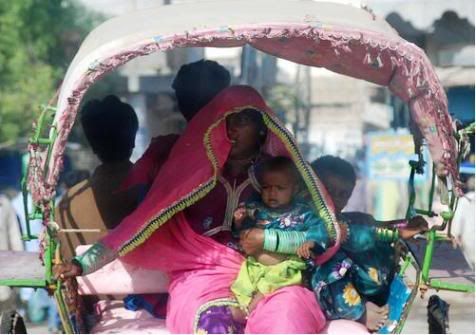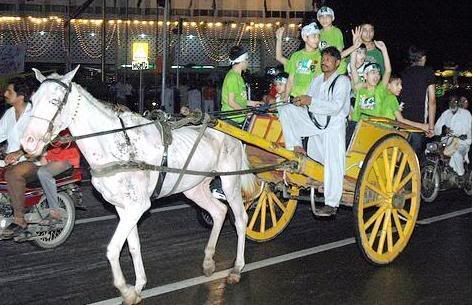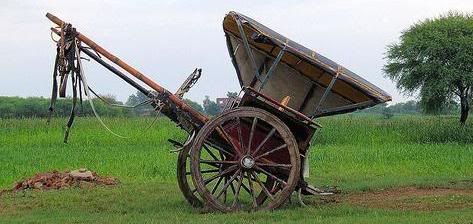Discussing Pakistan’s unique transport has remained a favourite topic at ATP (see Rickshaw, Truck, Tram, Bus and all modes of transport together in a post).
Today I want to pose a question to our readership. What do you think is the most challenging transport ride you’ve taken in Pakistan? If you ask me then there is only one possible answer and that is the challenge of sitting and not slipping at the back seat of a tonga.
You see the tonga owners all across Pakistan, for some reason, put a vinyl/plastic back seat cover. The urdu word for this material is mome-jaama. Now most of the tongas in Pakistan travel at a tilted angle anywhere between 30 degrees and 60 degrees. This tilt angle is directly proportional to the weight of back seat passengers and inversely proportional to the weight of coachman. To get a better picture, see this forward slash that I am going to type ( / ). Now imagine sitting on the back seat of a tonga at such a tilt, with a plastic seat cover underneath and not slipping. pretty tricky – huh.
The situation is even more challenging for children whose feet do not reach the foot board. I’ve had first hand experience of facing this serious challenge many times during my tonga rides from Lahore station to Misri Shah or do-moria-pul or on the inclines of old city Lahore.
One has to grab on to anything on a tonga’s frame for one’s dear life but if you are sitting in the center of the seat then there is no other option but to grab on to other people’s clothes to avoid slipping.
rau meiN hai rakhsh-e-umr, kahaaN dekhiye thamay
na hath baag par hai na paa hai rakaab meiN
As if this problem was not enough, imagine ladies holding small children in their laps and sitting on the back seat of a tonga.
I will refer our readers to the title photo of this post to appreciate this problem.
This situation is a 3-variable problem of dynamic motion. While the tonga moves forwards, the ladies keep slipping backwards and the babies in their laps also tend to slip backward but with a different acceleration. This is all because Newton once said that a=F/m where m is hugely different for mothers and babies. Therefore to over come Newtonian law and a Draconian seat, mothers have to be extra skilfull on a tonga.
If you think this is the end of a tonga’s back-seat dilemma then I will say three times in English: no, no and no and 3 more times in Urdu: na, na aur na. There is one more test reserved only for tonga’s back seat passengers. This happens when at a traffic light the tonga behind yours cannot stop in time (ghora bhi aakhir ko insaan hai – khataa ka putla hai – or atleast he is controlled by a human). In such cases the saliva foaming and smiling with green teeth face of a horse comes dangerously close to back seat passengers of front tonga. Imagine this situation in the graphics that I will type. It shows 3 tilting tongas and their horizontal horses. ( /horse3/horse2/horse1 ). Note how dangerously close horse 2 is to the back seat of tonga 1 and so on.
I’ve heard of real life situations where people in the back seat of a tonga ran away or screamed when the face of horse from the tonga behind them came too close.
This post is not an exaggeration. May be the tilt angle of a tonga ( / ) is a bit exaggerated but slipping on back seat of a tonga is very real and quite unique to this part of the world.
kis cheez ki kami hai khwaja teri gali meiN
GhoRa teri gali maiN, nathia teri gali meiN
I’ve even read this problem in Urdu literature. I believe I read it in late Ashfaq Ahmed’s one of zaavia series books.
Do you have any experience to share from a tonga’s slippery slope?
Photo Credits:
(1) Title photo is courtesy of Nida Shams
(2) n Bazmi
(2) Sir Cam






















































I remember it very well that how was it. Rear seat used to be steep and i would always go for front seat, thats when i was 8 years old, but when i grew up i felt its easy to settle on rear seat. if you closely look at this tonga cart in the green fields, you will notice that its foot pad actually part of its floor is curved backward for support. what i still cherish is the way the tonga rider was riding , he was saying it very frequently, slow meri jaan slow , (read it in sindhi accent).
well…practice for perfection :) I used to sit or rear seats because I liked so…even as a child. Vinyl is troublesome but you get used to it. It has been 10 years since I have been to my beloved city and to ride a tonga…nostalgic.
Wonderful post Owais.
This is the type of posts why ATP is the best blog and keeps you excited every day with some new idea. Now I will not get tangas out of my mind all day….
Thank yo Owais and Adil.
By the way, I think everyone should vote for ATP in the First Pakistan Blog Awards:
http://blogawards.pk/2010/01/06/current-affairs-bl og-pakistaniat/
Remember, click on the right-most (5th) star to vote and then REMEMBER To also write a comment at the bottom because I think they also count.
Thank yo ATP.
In my golden days of St. Patrick’s High School (actually 1 grade through 3 grade), we used to take a tonga ride every morning from Garden area to Saddar. The tongay wala used to take a 10 minute break at a water through at Soldier Bazar and feed him water and food. I don’t remember the exact location but that place still catered horses when I was in Pakistan in 2000. I don’t know if it still exists.
Nice article Owais. I grew up in Karachi and believe me have never been to Lahore so I cannot speak much about Lahori tongas. In Karachi, most of the horses hauled the victoria style buggy instead of a tonga. I am not saying that there are no tongas in Karachi…there are. I just never got a chance to ride in them. I am glad I never had to experience the tilt of the tonga seat :)
I have a question for our society in general. Why do women have to carry their children? Can’t the husband be man enough to help her out? I have seen this day in and day out that women would carry 3 – 4 children, grocery, her dupatta etc etc whereas the man would be either smoking away or would be playing with his moustache or the crouch area. Is this what our culture, our religion really teach us? When will our society realize that women play an integral role in shaping our society, our economy and our culture. They are not just to cook, clean and raise kids.